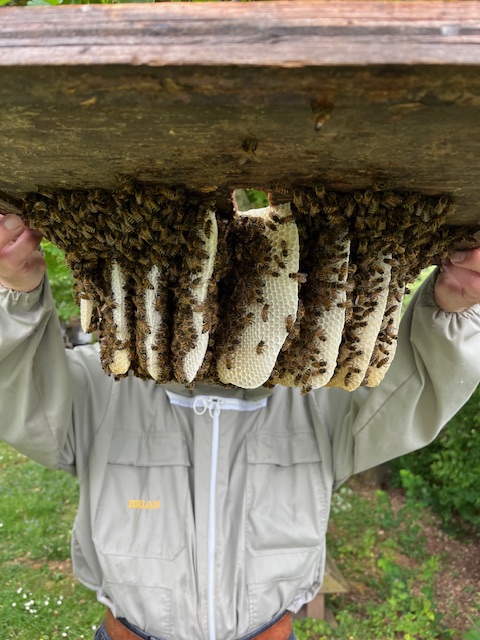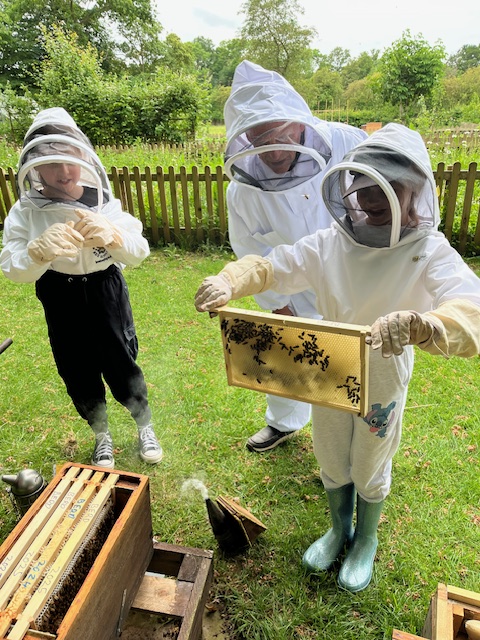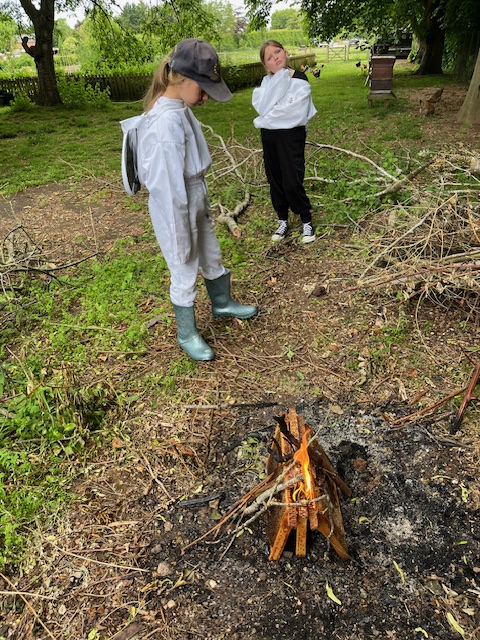Title Photo: European Hornet Nest in an empty Nuc
Well what a start to the season with ground frosts at the start of the month followed by really hot summer weather and a subsequent nectar flow followed by swarming galore.
I’m a little better prepared this year with “bait” hives out and about around the garden away from the Apiary but with empty hives with or without combs and Foundation all ready to go.
Then of course a European Hornet, hence the title picture above, decided to start building her nest in an empty Nuc box I’d renovated ready for use later in the season.
Needless to say before I had ejected her, nature took its course in the form of scout bees from a cast.
They first started to hassle her and then on a lovely sunny day moved into the Nuc en masse ejecting her to go and build a nest elsewhere .
I then had to wait until that evening to move the cast into a site in the main Apiary.
When working with swarms or casts you do at times wonder why you can still hear ‘buzzing bees’ as you try to exit the Apiary. Well the picture below shows you what the silly little blighters will gather on whilst still trying to locate their new home. If I’d had sat in the car that could have been difficult for all involved.

Then again leaving hives ready to place casts or swarms in can have its drawbacks, as for some daft reason I put an empty super above the brood chamber full of drawn comb.
The arriving colony clearly did not like the comb so decided to build comb on the crown board. Another problem, of my own making, to solve.


This month I’m lifting heavy supers full of spring honey off colonies trying to practice good swarm control – they don’t tell you about this in the books.
Anyway once several heavy supers have been lifted off, you find Queen cups or cells so have to take some form of action.
I will try and keep it simple: move the entire brood chamber at least ten feet away meaning all the older flying bees will return to the original site.
I then take one drawn comb with a Queen cup or Queen cell and put it back onto the original site, in a brood chamber with 10 other frames of foundation.
That afternoon or the next morning, back to the Apiary to tackle the original brood chamber full of Queen cups Queens cells and a lot less bees most of which will be young, ready for Queen rearing.
I then split this brood chamber into 2 or 3 Nucs with two combs of food, 1 brood and only leave 1 Queen cup or Queen cell.
Then leave alone for 2 or 3 weeks depending on the weather. Open up and hopefully find a mated laying Queen which you can easily find and mark.
The astute amongst you may ask what do you do about the old Queen, well if I find her she goes into a Nuc with combs, food and brood but no Queen cells.
If I cannot find her, often happens, I let nature take its course one way or the other…..
These Nucs I will not take honey off, yes I know I’m optomistic, but let them build into 11 frame colonies to bring through the winter to replace any losses or maybe sell to Apiarists next year.
After the wonderful Nectar flow from Oil seed Rape, Hawthorn, Horse chestnut and other spring flowers there was a bit of a dearth at the end of the month whilst we await (rain) for the summer flowers to bloom.
I see the Lime trees are ready to burst into flower together with Clover and Blackberry, all wonderful nectar providers.
Those who have honey to take off and extract, it’s a good time to progress this at the end of the month but remember to put empty supers under the full ones so the bees have somewhere to clear down into.
Right! – Who has any empty hives in their Apiary? Please let Terry know as the swarming season is not over yet and we will try to keep you supplied with local swarms for you.
Next Month: How to breed Queens from your favourite hive, not that one that swarms a lot.
Also get that spare Broodchamber full of foundation and onto your strongest hive as a super above the Queen excluder. These beautifully drawn combs once extracted in the late summer can be used to replace ropey combs next spring.
Always a good idea to have couple spare children’s veils around so when family visit they can enjoy the delight of Beekeeping at an early age.
Their Grandad started keeping bees a couple of seasons ago so they just had to look into one of my friendly hives with a smoker each to keep them occupied. Note socks tucked over trousers – not enough wellies to go around and rather large gloves!



